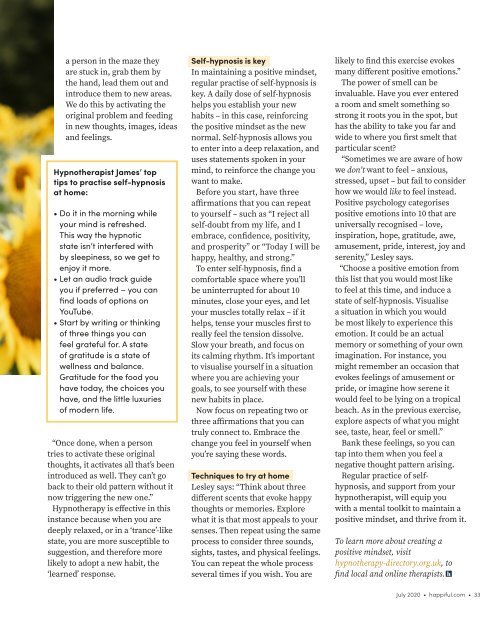Create successful ePaper yourself
Turn your PDF publications into a flip-book with our unique Google optimized e-Paper software.
a person in the maze they<br />
are stuck in, grab them by<br />
the hand, lead them out and<br />
introduce them to new areas.<br />
We do this by activating the<br />
original problem and feeding<br />
in new thoughts, images, ideas<br />
and feelings.<br />
Hypnotherapist James’ top<br />
tips to practise self-hypnosis<br />
at home:<br />
• Do it in the morning while<br />
your mind is refreshed.<br />
This way the hypnotic<br />
state isn’t interfered with<br />
by sleepiness, so we get to<br />
enjoy it more.<br />
• Let an audio track guide<br />
you if preferred – you can<br />
find loads of options on<br />
YouTube.<br />
• Start by writing or thinking<br />
of three things you can<br />
feel grateful for. A state<br />
of gratitude is a state of<br />
wellness and balance.<br />
Gratitude for the food you<br />
have today, the choices you<br />
have, and the little luxuries<br />
of modern life.<br />
“Once done, when a person<br />
tries to activate these original<br />
thoughts, it activates all that’s been<br />
introduced as well. They can’t go<br />
back to their old pattern without it<br />
now triggering the new one.”<br />
Hypnotherapy is effective in this<br />
instance because when you are<br />
deeply relaxed, or in a ‘trance’-like<br />
state, you are more susceptible to<br />
suggestion, and therefore more<br />
likely to adopt a new habit, the<br />
‘learned’ response.<br />
Self-hypnosis is key<br />
In maintaining a positive mindset,<br />
regular practise of self-hypnosis is<br />
key. A daily dose of self-hypnosis<br />
helps you establish your new<br />
habits – in this case, reinforcing<br />
the positive mindset as the new<br />
normal. Self-hypnosis allows you<br />
to enter into a deep relaxation, and<br />
uses statements spoken in your<br />
mind, to reinforce the change you<br />
want to make.<br />
Before you start, have three<br />
affirmations that you can repeat<br />
to yourself – such as “I reject all<br />
self-doubt from my life, and I<br />
embrace, confidence, positivity,<br />
and prosperity” or “Today I will be<br />
happy, healthy, and strong.”<br />
To enter self-hypnosis, find a<br />
comfortable space where you’ll<br />
be uninterrupted for about 10<br />
minutes, close your eyes, and let<br />
your muscles totally relax – if it<br />
helps, tense your muscles first to<br />
really feel the tension dissolve.<br />
Slow your breath, and focus on<br />
its calming rhythm. It’s important<br />
to visualise yourself in a situation<br />
where you are achieving your<br />
goals, to see yourself with these<br />
new habits in place.<br />
Now focus on repeating two or<br />
three affirmations that you can<br />
truly connect to. Embrace the<br />
change you feel in yourself when<br />
you’re saying these words.<br />
Techniques to try at home<br />
Lesley says: “Think about three<br />
different scents that evoke happy<br />
thoughts or memories. Explore<br />
what it is that most appeals to your<br />
senses. Then repeat using the same<br />
process to consider three sounds,<br />
sights, tastes, and physical feelings.<br />
You can repeat the whole process<br />
several times if you wish. You are<br />
likely to find this exercise evokes<br />
many different positive emotions.”<br />
The power of smell can be<br />
invaluable. Have you ever entered<br />
a room and smelt something so<br />
strong it roots you in the spot, but<br />
has the ability to take you far and<br />
wide to where you first smelt that<br />
particular scent?<br />
“Sometimes we are aware of how<br />
we don’t want to feel – anxious,<br />
stressed, upset – but fail to consider<br />
how we would like to feel instead.<br />
Positive psychology categorises<br />
positive emotions into 10 that are<br />
universally recognised – love,<br />
inspiration, hope, gratitude, awe,<br />
amusement, pride, interest, joy and<br />
serenity,” Lesley says.<br />
“Choose a positive emotion from<br />
this list that you would most like<br />
to feel at this time, and induce a<br />
state of self-hypnosis. Visualise<br />
a situation in which you would<br />
be most likely to experience this<br />
emotion. It could be an actual<br />
memory or something of your own<br />
imagination. For instance, you<br />
might remember an occasion that<br />
evokes feelings of amusement or<br />
pride, or imagine how serene it<br />
would feel to be lying on a tropical<br />
beach. As in the previous exercise,<br />
explore aspects of what you might<br />
see, taste, hear, feel or smell.”<br />
Bank these feelings, so you can<br />
tap into them when you feel a<br />
negative thought pattern arising.<br />
Regular practice of selfhypnosis,<br />
and support from your<br />
hypnotherapist, will equip you<br />
with a mental toolkit to maintain a<br />
positive mindset, and thrive from it.<br />
To learn more about creating a<br />
positive mindset, visit<br />
hypnotherapy-directory.org.uk, to<br />
find local and online therapists.<br />
<strong>July</strong> <strong>2020</strong> • happiful.com • 33

















